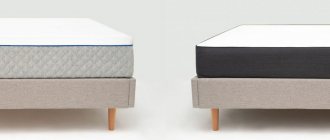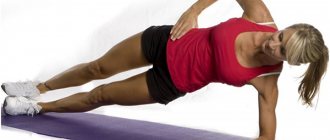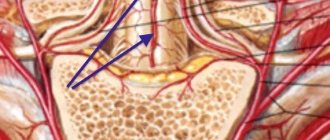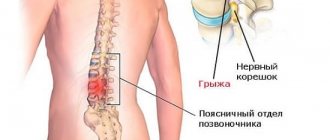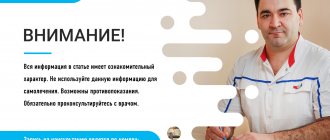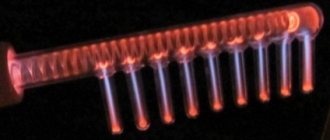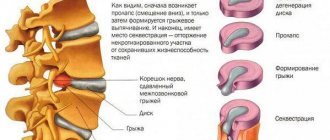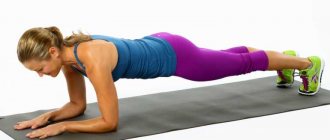A corset will help to significantly ease the course of the disease and reduce the load on the spine, speed up recovery and establish normal functioning of the body in case of a disease such as a vertebral hernia, especially localized in the lumbar area. Conservative treatment is not possible without this orthopedic device, and a corset can help even in the presence of serious complications.
Corset for hernia of the lumbar spine
How a corset helps get rid of a hernia
To understand the need to use this device in the complex treatment of a vertebral hernia, it is necessary to remember what a hernia is and how it forms.
A number of vertebrae make up the spinal column, and between them there are connecting “spacers” - discs. They play the role of a shock-absorbing pillow, a very important role, without which the entire spine will be deprived of the flexibility and mobility necessary for a person to walk, move, and perform various actions. The composition of the discs is connective tissue, but inside there is a core, which is a liquid. Over the years (due to age-related tissue changes) or due to various pathological conditions, fluid leaves the discs, the center shifts, and a hernia forms.
Stages of hernia development
Intervertebral hernia
By the way. A hernial formation has the effect of pinching a nerve, causing pain, limited mobility and discomfort. Most often this happens in the lumbar area, therefore, when we talk about a vertebral hernia, we usually mean a lumbar hernia.
Symptoms of lumbar intervertebral hernia
Why does a lumbar hernia form?
- Due to physical activity that is carried out for a long time.
- Due to short-term but excessive physical activity.
- Due to injury.
- Due to a fall, especially from a height or on your back.
- When lifting heavy objects in an awkward or incorrect position.
- Due to being in an unnatural or uncomfortable position for a long time (bent, “crooked” state).
- Due to poor posture.
Causes of hernias
By the way. A lumbar hernia is severe pain, complications expressed by numbness of the lower body, legs, weakness, lack of coordination, disturbance of gait and movement functions. At the same time, the person is not able to lead a normal lifestyle and engage in usual activities.
Of course, at the stage when the patient comes to the doctor with complaints of lower back pain or numbness in the legs, and he is diagnosed with a lumbar hernia, treatment for the disease begins immediately. The complex of therapeutic measures includes drug therapy, physiotherapy, exercise therapy, massage and, of course, wearing a corset.
Wearing a corset for intervertebral hernia is mandatory
Important! The corset reduces the load on the spinal area and limits, to a certain extent, motor activity, which is very important in case of a hernia. The belt area is the most mobile after the neck area. The vertebrae here are mobile and are not protected by costal plates, as in the thoracic area, or pelvic bones, as in the sacral area.
A corset is needed on the lower back so that its rigid ribs reduce the pressure acting on the disc space and, accordingly, on the damaged disc itself. This will greatly help slow down deformation changes in the vertebrae. The nerve endings will be freed from the clamp, and the pain will gradually subside.
Wearing a corset is necessary to reduce pain due to reducing the load on the damaged intervertebral disc
Functions of lumbar corsets.
- Spine stretching.
- Stretching each vertebra.
- Relieving pain by reducing pressure on the disc.
- Improving posture, returning the vertebrae to the correct position.
- Normalization of blood flow.
- Muscle relaxation.
When treating any type of hernia, the doctor, in combination, among other prescriptions, will definitely prescribe a corset.
If you want to know how to choose a suitable orthopedic belt for your back, consider their varieties and characteristics, you can read an article about this on our portal.
When can you sit down after surgery?
It is prohibited to decide on your own when you can sit down; this restriction can be lifted only by a competent specialist. Depending on the severity of the operation, as a rule, a complete ban on taking the “sitting” position lasts approximately 4-6 weeks. After the restriction is lifted, you will be taught how to sit down correctly, but at first you will only be able to sit down without putting stress on your tailbone. Before you begin, make sure that the seating surfaces are not too low. How to correctly take a pose, what deflection of the spine to maintain, how to stand up, and so on, you will learn all this in due time. At first, it is only permissible to sit on the edge of a chair, with your knees below your hip joints. It is necessary to sit and stand with your hands on your knees or chair armrests.
X-ray stabilization system. When using it, you can sit down much earlier.
How to use
A lumbar model or thoracolumbar model is not just an optional accessory for a hernia, it is a mandatory device that will allow you to get rid of the disease without resorting to surgery. Its use accelerates the process of straightening the spine, allowing it to be stretched to its maximum. By wearing a corrective corset, the activity of the spinal segments increases, and the patient gets rid of pain.
For small hernias at the initial stage of pathology, a compensatory preventive corset is usually used. It corrects minor deviations in posture and is always worn by patients with a lumbar hernia if they engage in physical labor or certain exercises.
Soft lumbar corset
If you want to know how to choose the best back corset for stooping, and also consider the best options for their types and shapes, you can read an article about this on our portal.
When the disease worsens and leaves the initial stage, a semi-rigid corset replaces the preventive corset. Its design is elastic, and must be worn during physical activity and in everyday life, when the patient is in an upright position.
Semi-rigid thoracolumbar corset
Important! Semi-rigid and rigid corsets cannot be used if the patient is lying down. Before going to bed or resting, such models must be removed. While a soft wool belt for a warming effect can, in consultation with your doctor, be left on the body overnight.
The semi-rigid model helps to significantly reduce pain, increase lumbar mobility and normalize motor functions. This type of orthopedic product has an individual duration of use, which depends on the specified diagnosis. It can be worn for six hours or more if necessary, but must be removed at night. The main purpose of wearing this product is to relieve the spine.
Orthopedic lumbosacral corset
Prices for lumbosacral corset
As for rigid models, they are most often prescribed to be worn after surgery for fixation during the rehabilitation period, since they provide full support to the spine, limiting its mobility. Also, such a corset can be prescribed for a sequestered hernia, after its release and after traction of the spine, when it is performed to release a pinched nerve.
Features of rigid corsets
There are strict rules for wearing tight corset designs. Since these models are massive, wearing them cannot last more than six hours at a time, and in no case should they continue if a person changes a vertical position to a horizontal one.
Rigid orthopedic corset
By the way. Such structures, even if they are used only in the lumbar region, support several spinal zones at once, almost the entire spinal column, except for the neck.
The rigidity is affected by the design, namely the material of the ribs that are used for the fixing frame, or the encircling plates. The more clamps, the more rigid the entire structure.
The most flexible corset, which can be classified as semi-rigid, has four ribs (two on both sides of the spine, located vertically. There can also be six ribs, which enhances the effect. In the most rigid products, plates are placed that encircle the lower back.
Orthopedic product size
The choice of a semi-rigid orthopedic corset should take into account the anatomical features of the figure. The size range of products manufactured by different manufacturers may vary significantly.
When choosing a corset, you most often need to focus on waist size. But there are also orthopedic products, the size of which is determined by the circumference of the back.
When measuring your waist, the measuring tape should fit as closely as possible to your body. It should not be loosened or tightened too much.
Purchasing and wearing
You can buy lumbar corsets of a semi-rigid or rigid model only with a doctor’s prescription and in specially designated places. The sale of corset medical products is carried out by many general pharmacies, specialized orthopedic pharmacies, offices, and companies that manufacture such products under a license to order.
Advice. You can use the services of an online store, of which there are now many. Upon purchase, the product will be delivered directly to your home. But it is very easy to make a mistake with the sizes here. A semi-rigid, and especially a rigid corset must be carefully measured, so it is best to make the latter immediately to order according to your own measurements.
A corset to be worn for a lumbar hernia should have comfortable wide straps or other fasteners, for example, wide Velcro. When the product is put on and adjusted to fit your figure, it should not press anywhere and cause discomfort. At the same time, the fabric fits tightly around the waist, otherwise there will be no therapeutic effect from wearing it.
How to choose a corset
The price of a corrective corset depends on the model. The cheapest are soft products. Next, in the next price category there are semi-rigid models. The most expensive are rigid corsets.
Corrective corset for the spine
Important! Under no circumstances should you think that the stiffer (more expensive) the corset is, the better it will help. The doctor prescribes exactly the model that is relevant and effective at the moment, at this stage of the disease.
And there is no need to try to make a corset yourself. Despite the apparent simplicity of the design of the product, even if you have sewing skills, a lumbar corset for a hernia should be made by an orthopedic specialist. Otherwise, instead of getting rid of the disease, you can cause irreparable harm to yourself and get a disability, or be referred to a surgical operation, which can be completely avoided by using a corset according to the rules and in accordance with necessity.
Caring for orthopedic braces
Video - Lumbar corset
Video - Using a corset for lumbar pain (advice from a neurologist)
Diagnosis of thoracic pathology
The disease is diagnosed based on anamnestic data, the results of neurological tests and instrumental methods for examining the thoracic spine. A primary role in diagnosis is played by methods of visualization of the corresponding area of the musculoskeletal system.
Magnetic resonance imaging is recognized as the most accurate method for making a diagnosis. Using MRI, soft paravertebral structures and all components of the spine are visualized layer by layer, including intervertebral discs, spinal cord, and neurovascular formations. Thanks to MRI, the specialist receives the necessary array of information:
- location and direction of the outbreak, its volume;
- the condition of adjacent bone structures, joints and ligaments;
- level of damage to nerve roots, spinal vessels;
- condition of the spinal cord and sagittal size of the spinal canal;
- the presence of concomitant diseases in the area under study (for example, vertebral hemangiomas, spinal cord tumors, neurinoma, spondylosis, etc.).
An example of computed tomography imaging.
If for some reason the patient cannot undergo MRI, he will be recommended the second most diagnostic imaging method - computed tomography. However, although CT visualizes a hernia, it does not have the ability to reliably determine the parameters of the protrusion and the degree of spinal compression. Conventional radiography provides the least information regarding the confirmation and characteristics of the disease, since it allows only the assessment of bone structures, so it is rarely used.
As additional examination methods, the patient may be recommended electroneuromyography (assessment of the bioelectric potentials of skeletal muscles) and myelography (a study with contrast of the cerebrospinal fluid tract). Also, if there is a differential need, the patient may be referred for:
- X-ray or fluorography of the lungs (to exclude/detect pneumonia, pleurisy, pulmonary neoplasms);
- Doppler ultrasound (USDG) of the coronary vessels and ECG (to exclude/detect cardiac pathologies);
- gastroscopy EGDS, ultrasound of the digestive organs (for the purpose of refuting/confirming gastrointestinal diseases);
- Ultrasound of the urinary tract and kidneys, urography, urine analysis (to exclude/confirm glomerular nephritis, urolithiasis, pyelonephritis).
Intervertebral hernia - clinics in
Choose among the best clinics based on reviews and the best price and make an appointment
Family
Oriental Medicine Clinic "Sagan Dali"
Moscow, prosp.
Mira, 79, building 1 Rizhskaya
+7
- Consultation from 1500
- Diagnostics from 0
- Reflexology from 1000
0 Write your review
Family
Back and joint treatment clinic No. 1
Moscow, Pyatnitskoye sh., 6, bldg.
1 VolokolamskayaMitino
+7
- Consultation from 1000
- Treatment courses from 7000
- Massage from 1500
10 Write your review
Family
Institute of Traditional Oriental Medicine
Moscow, Filippovsky lane, 18
Arbatskaya (FL)
8-(495) 691-66-69
registry
- Consultation from 1200
- Manual therapy from 1300
- Physiotherapy from 700
0 Write your review
Show all Moscow clinics
Intervertebral hernia - specialists in Moscow
Choose among the best specialists based on reviews and the best price and make an appointment with
an Orthopedic Surgeon
Dubinsky Artyom Igorevich
Moscow, st.
Sretenka, 9 (Capital Medical Clinic) +7 0 Write your review
VertebrologistOrthopedistSurgeon
Sychenikov Boris Anatolievich
Moscow, st. Avtozavodskaya, 16, bldg. 2 (Clinic “Medicine 24/7”)
+7
0 Write your review
VertebrologistOrthopedistSurgeon
